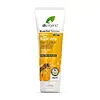What's inside
What's inside
 Key Ingredients
Key Ingredients

 Benefits
Benefits

 Concerns
Concerns

 Ingredients Side-by-side
Ingredients Side-by-side

Hamamelis Virginiana Water
AstringentGlycerin
HumectantWater
Skin ConditioningCarrageenan
Caffeine
Skin ConditioningCoffea Arabica Seed Extract
MaskingRosa Canina Fruit Extract
AstringentTanacetum Annuum Flower/Leaf/Stem Oil
MaskingPalmitoyl Tripeptide-5
Skin ConditioningSodium Hyaluronate
HumectantPanthenol
Skin ConditioningMicrocrystalline Cellulose
AbsorbentGlucose
HumectantLecithin
EmollientCellulose Gum
Emulsion StabilisingPolysorbate 20
EmulsifyingPhenoxyethanol
PreservativeEthylhexylglycerin
Skin ConditioningSodium Benzoate
MaskingHamamelis Virginiana Water, Glycerin, Water, Carrageenan, Caffeine, Coffea Arabica Seed Extract, Rosa Canina Fruit Extract, Tanacetum Annuum Flower/Leaf/Stem Oil, Palmitoyl Tripeptide-5, Sodium Hyaluronate, Panthenol, Microcrystalline Cellulose, Glucose, Lecithin, Cellulose Gum, Polysorbate 20, Phenoxyethanol, Ethylhexylglycerin, Sodium Benzoate
Aloe Barbadensis Leaf Juice
Skin ConditioningWater
Skin ConditioningDicaprylyl Ether
EmollientPolyglyceryl-3 Methylglucose Distearate
EmulsifyingGlycerin
HumectantCaprylic/Capric Triglyceride
MaskingIsocetyl Palmitate
EmollientCetearyl Alcohol
EmollientMyristyl Myristate
EmollientOlea Europaea Oil Unsaponifiables
Skin ConditioningTheobroma Cacao Seed Butter
EmollientButyrospermum Parkii Butter
Skin ConditioningOlea Europaea Fruit Oil
MaskingGlyceryl Caprylate
EmollientTocopherol
AntioxidantHelianthus Annuus Seed Oil
EmollientMel
EmollientGlycyrrhetinic Acid
Skin ConditioningRetinyl Palmitate
Skin ConditioningXanthan Gum
EmulsifyingChondrus Crispus Extract
Skin ConditioningJuniperus Virginiana Oil
MaskingCitrus Medica Peel Oil
Pelargonium Graveolens Oil
MaskingPogostemon Cablin Leaf Oil
MaskingCitrus Aurantium Amara Leaf/Twig Oil
MaskingSantalum Album Oil
MaskingParfum
MaskingTrifolium Pratense Flower Extract
AstringentCalluna Vulgaris Flower Extract
Skin ConditioningRoyal Jelly Extract
Skin ConditioningSodium Benzoate
MaskingPotassium Sorbate
PreservativeSodium Phytate
Citric Acid
BufferingAscorbic Acid
AntioxidantLimonene
PerfumingGeraniol
PerfumingHydroxycitronellal
PerfumingLinalool
PerfumingCitronellol
PerfumingHexyl Cinnamal
PerfumingAloe Barbadensis Leaf Juice, Water, Dicaprylyl Ether, Polyglyceryl-3 Methylglucose Distearate, Glycerin, Caprylic/Capric Triglyceride, Isocetyl Palmitate, Cetearyl Alcohol, Myristyl Myristate, Olea Europaea Oil Unsaponifiables, Theobroma Cacao Seed Butter, Butyrospermum Parkii Butter, Olea Europaea Fruit Oil, Glyceryl Caprylate, Tocopherol, Helianthus Annuus Seed Oil, Mel, Glycyrrhetinic Acid, Retinyl Palmitate, Xanthan Gum, Chondrus Crispus Extract, Juniperus Virginiana Oil, Citrus Medica Peel Oil, Pelargonium Graveolens Oil, Pogostemon Cablin Leaf Oil, Citrus Aurantium Amara Leaf/Twig Oil, Santalum Album Oil, Parfum, Trifolium Pratense Flower Extract, Calluna Vulgaris Flower Extract, Royal Jelly Extract, Sodium Benzoate, Potassium Sorbate, Sodium Phytate, Citric Acid, Ascorbic Acid, Limonene, Geraniol, Hydroxycitronellal, Linalool, Citronellol, Hexyl Cinnamal
Ingredients Explained
These ingredients are found in both products.
Ingredients higher up in an ingredient list are typically present in a larger amount.
Glycerin is already naturally found in your skin. It helps moisturize and protect your skin.
A study from 2016 found glycerin to be more effective as a humectant than AHAs and hyaluronic acid.
As a humectant, it helps the skin stay hydrated by pulling moisture to your skin. The low molecular weight of glycerin allows it to pull moisture into the deeper layers of your skin.
Hydrated skin improves your skin barrier; Your skin barrier helps protect against irritants and bacteria.
Glycerin has also been found to have antimicrobial and antiviral properties. Due to these properties, glycerin is often used in wound and burn treatments.
In cosmetics, glycerin is usually derived from plants such as soybean or palm. However, it can also be sourced from animals, such as tallow or animal fat.
This ingredient is organic, colorless, odorless, and non-toxic.
Glycerin is the name for this ingredient in American English. British English uses Glycerol/Glycerine.
Learn more about GlycerinSodium Benzoate is a preservative. It's used in both cosmetic and food products to inhibit the growth of mold and bacteria. It is typically produced synthetically.
Both the US FDA and EU Health Committee have approved the use of sodium benzoate. In the US, levels of 0.1% (of the total product) are allowed.
Sodium benzoate works as a preservative by inhibiting the growth of bacteria inside of cells. It prevents the cell from fermenting a type of sugar using an enzyme called phosphofructokinase.
It is the salt of benzoic acid. Foods containing sodium benzoate include soda, salad dressings, condiments, fruit juices, wines, and snack foods.
Studies for using ascorbic acid and sodium benzoate in cosmetics are lacking, especially in skincare routines with multiple steps.
We always recommend speaking with a professional, such as a dermatologist, if you have any concerns.
Learn more about Sodium BenzoateWater. It's the most common cosmetic ingredient of all. You'll usually see it at the top of ingredient lists, meaning that it makes up the largest part of the product.
So why is it so popular? Water most often acts as a solvent - this means that it helps dissolve other ingredients into the formulation.
You'll also recognize water as that liquid we all need to stay alive. If you see this, drink a glass of water. Stay hydrated!
Learn more about Water